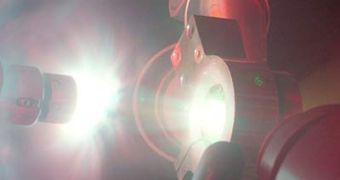The experiment was conceived by the U.S. Department of Energy's Argonne National Laboratory, to determine how oxide glass structures behave under extreme pressures. A diamond cell was uniquely constructed using a microscopic laser, to house pressures up to 32 gigapascals, equivalent to a tenth of the pressure at the center of the Earth.
By smashing vitreous arsenic oxide samples between the anvils cells created in the diamond, researchers were able to determine how such structures behave in high-pressures, with unprecedented detail. This kind of research is critical for the understanding of how matter at the center of the Earth behaves, because oxide glasses and liquids represent a large percentage of the materials that compose it, giving geophysical science valuable information.
For example, knowing oxide glasses under extreme pressure gives scientists a view of how magma behaved during the formation of the Earth and the Moon. The technique gives information about how different silicate glasses interact, and the complex behavior of the melting process which took place during the mantle formation.
They observed that arsenic oxide under extreme pressures suffers a transformation at 20 GPa, when the color changed from transparent to red, but could not link it to a possible atomic cause. X-ray investigation showed that an atomic reconfiguration triggered this behavior. Under normal pressures, the arsenic atoms exhibit isolated molecular "cages", in which it is surrounded by six oxygen atoms, bound to two arsenic atoms. When the 20 GPa pressure is reached, multiple molecular "cages" colapse to create new isomers, in which one arsenic atom in bound to six oxygen atoms.
Previous experiments used regular diamond anvils, but they caused too much background scattering which obscured the signals emitted from the material. Mechanically drilled anvils were also used previously, but failed at pressures above 15 GPa. This was the first experiment that used laser drilled anvils and x-ray diffraction.

 14 DAY TRIAL //
14 DAY TRIAL //